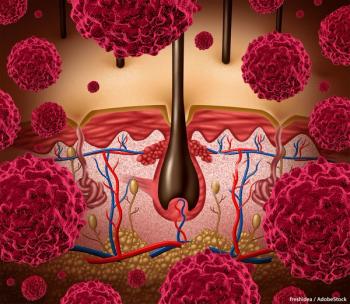
Melanoma Therapy Overview at SMR 2013
At the 10th International Congress of the Society for Melanoma Research (SMR), we spoke with Dr. Georgina Long about current targeted approaches for the treatment of advanced-stage melanoma.
At the 10th International Congress of the Society for Melanoma Research (SMR), we spoke with Dr. Georgina Long about current targeted approaches for the treatment of advanced-stage melanoma. Dr. Long is a medical oncologist specializing in melanoma at the Melanoma Institute Australia at the University of Sydney, where she treats patients with melanoma, takes part in clinical trials of both metastatic and adjuvant melanoma therapies, and studies the molecular biology of this disease.
-Interviewed by
Cancer Network: Dr. Long, can you provide a brief overview of the current treatment options available for both stage III and stage IV melanoma, the type that has progressed from the primary site to the lymph nodes or even other organs?
Dr. Long: The current available treatments outside of a clinical trial for stage III melanoma-that’s melanoma that has progressed to the lymph nodes that is completely resected, so the patient is free of disease-is interferon therapy for 12 months. This decreases the risk of relapse by about 10%. We haven’t yet worked out which patient population really gets the most benefit from interferon, given that it is a reasonably toxic treatment. Within stage IV melanoma, which is melanoma that has spread to distant organs, the standard treatments that are widely available outside of a clinical trial include two BRAF inhibitors, vemurafenib and dabrafenib, used as single agents, and trametinib, a MEK inhibitor used as a single agent, as well as ipilimumab, a cytotoxic T-lymphocyte antigen-4 (CTLA-4) immunotherapy, and of course chemotherapy.
Now, outside of a clinical trial, if a patient has a BRAF mutation in the melanoma-and this includes any V600 BRAF mutation, not just V600E-it is necessary that you do a test that covers all relevant V600 mutations, because if all these patients benefit, then you would consider treating with a BRAF inhibitor. I would not propose a MEK inhibitor for these patients; it should be a BRAF inhibitor. There are very interesting combinations of BRAF plus MEK inhibitors, which improve the progression-free survival of these metastatic patients even further, but this combination is not yet approved for widespread use outside of a clinical trial. The big question though, comes for the BRAF-mutated patients. Do you start with an immunotherapy or do you start with targeted therapy first? That question is not answered. There is some very biased data that suggest you may be better off giving immunotherapy, ipilimumab first. However, if the patient has disease progression, you really do reach for a BRAF inhibitor because these drugs work so quickly and so effectively, and they are in an oral tablet form. These are the standard treatments for melanoma outside of a clinical trial. For wild-type BRAF patients, the treatment, of course, is ipilimumab, the immunotherapy.
Cancer Network: What are some of the important phase III trials ongoing now that are testing targeted agents in melanoma? You mentioned the combination of the BRAF plus MEK inhibitor.
Dr. Long:Let me talk about stage III melanoma first. The phase III trial of ipilimumab for stage III patients is ongoing, and the results of that will be out in the coming months-we are hoping these will be presented at ASCO 2014. That will tell us whether a period of treatment with this immunotherapy decreases your chance of progressing to metastatic disease. The second trial that is ongoing in stage III melanoma is in the V600 BRAF-mutated population. That is looking at the combination of the BRAF inhibitor dabrafenib plus the MEK inhibitor trametinib for 12 months vs placebo to see if we can decrease the chance of the melanoma recurring and becoming a stage IV disease. Recruitment to that is continuing and is widely available internationally. We should be completed with recruitment around mid-2014.
Now in the metastatic setting, there are many, many exciting phase III trials. The combination trials for BRAF-mutated disease of dabrafenib plus trametinib vs dabrafenib or vemurafenib-those trials are finished with recruitment and we should be getting the results of those trials in the next 6 months, or at least one of those. Ongoing trials with the Roche combination of a BRAF plus MEK inhibitor-vemurafenib, the BRAF inhibitor plus cobimetinib, the MEK inhibitor vs vemurafenib alone-that trial is continuing to recruit. There is another phase III trial that has just started up of the Novartis combination of their BRAF inhibitor, LGX818, plus their MEK inhibitor, MEK-162, vs both vemurafenib alone or LGX818 alone-it’s a three-arm study. That is open for recruitment.
In terms of the exciting immunotherapies that are available through phase III clinical trials-and I am just mentioning those in phase III studies, not phase II or phase I studies-the Bristol-Myers Squibb study of ipilimumab vs the anti–PD-1 antibody nivolumab vs the combination of ipilimumab with nivolumab is ongoing and recruiting. There is also a nivolumab alone vs the chemotherapy dacarbazine study, which is ongoing mainly in Europe. Another study involves the Merck anti–PD-1 antibody, MK-3475, in two different doses, so two different arms with different dosage frequency, one every 2 weeks and the other every 3 weeks both at 10 mg/kg vs ipilimumab, and in that study, it can be first- or second-line. These are the major phase III trials of immunotherapy in melanoma, and that is not discussing any of the exciting phase I or II trials of both targeted therapies and immunotherapies that are ongoing.
Cancer Network: Are there other mutations or biomarkers in melanoma for which there are targeted agents in development in a clinical trial?
Dr. Long:There are plenty of other mutations or biomarkers in melanoma for which there are targeted agents. In fact, we know that for KIT mutations, which occur in about 2% to 3% of patients overall but more heavily in mucosal melanoma and acral melanoma, there are KIT inhibitors that are ongoing in trials. For ocular melanoma and uveal melanoma, we are looking at MEK inhibitors, subdivided by the GNAQ mutations that occur in about 80% to 90% of ocular melanoma, but it seems from early phase II studies that the MEK inhibitors work in ocular melanoma regardless of whether the GNAQ mutations are present in the tumor. The third one I haven’t mentioned is the NRAS mutation, which occurs in about 20% to 25%, depending on which country, so maybe 15% to 25% of melanomas. There are studies ongoing with targeted therapies for NRAS-mutated melanoma.
What we are really discovering is that melanoma is very heterogeneous and although you may have one of the big three mutations, there can be other aberrations in the tumor-for example, PTEN loss, p53 mutations, and p16 loss that can co-occur with the big three mutations, which are mutually exclusive. That is an important point: The big three mutations are mutually exclusive, so if you have a BRAF mutation, you are not going to have an NRAS mutation or a KIT mutation. But these other smaller mutations can co-occur with any of those big three, and they actually may augment the response to targeted therapy. We are starting to do work, looking at subpopulations within the BRAF, NRAS, and KIT groups. A lot of activity, a lot of targeted therapies; the backbone though are the MEK inhibitors for NRAS-mutated disease.
Cancer Network: Thank you so much for joining us today, Dr. Long!
Dr. Long:Thank you for having me.
Newsletter
Stay up to date on recent advances in the multidisciplinary approach to cancer.





















































































